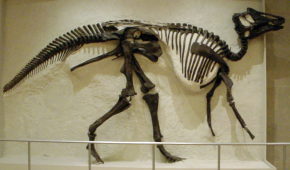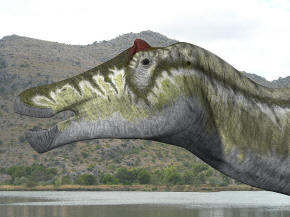skull around 0.9 meters long (2.9 ft) on a ~8.5 meter long skeleton (~28
ft). It had a small, stout, triangular crest in
front of the eyes; the sides of this crest were concave, forming
depressions. The upper arm was relatively short.
Otherwise, its anatomy was
unremarkable for a hadrosaurine hadrosaurid. Like nearly all hadrosaurids,
the whole front of the skull was flat and broadened out to form a beak,
ideal for clipping leaves and twigs from the forests of North America. The
back of the mouth contained thousands of teeth suitable for grinding food
before it was swallowed.
The two species are differentiated
by details of the crest, and in profile, P.
blackfeetensis is restored with a steeper,
taller face than P. maximus.
In P. blackfeetensis,
at least, the crest migrated backward toward the eyes during growth.
Classification
Because of its name,
Prosaurolophus is often
associated with Saurolophus.
However, this is contentious; some authors have found the animals to be
closely related, whereas others have not, instead finding it closer to
Brachylophosaurus,
Edmontosaurus,
Gryposaurus, and
Maiasaura. It was a
hadrosaurine hadrosaur, meaning it lacked a hollow crest.
The cladogram to the right is based
on the 2004 review by Jack Horner, David B. Weishampel, and Catherine
Forster, in the second edition of The
Dinosauria. In this review,
Prosaurolophus is closest
to Gryposaurus.
This is only one of many proposed cladograms for hadrosaurids.
History
Well-known paleontologist Barnum
Brown recovered a duckbill skull in 1915 for the American Museum of Natural
History (AMNH 5836) from the Red Deer River of Alberta, near Steveville. He
described the specimen in 1916 as a new genus,
Prosaurolophus. Brown's choice of name comes
from a comparison to the genus Saurolophus,
which he had described in 1912. Saurolophus
had a similar but longer and more spike-like head crest. The skull had a
damaged muzzle and was inadvertently reconstructed too long, but better
remains were soon found that showed the true shape; one is a nearly complete
skeleton and skull, described by William Parks in 1924. 20 to 25 individuals
are known for this species, including seven skulls with at least some of the
rest of the skeleton.
The second species,
P. blackfeetensis, is
based on a specimen in the Museum of the Rockies (MOR 454), which was
described by another notable paleontologist, Jack Horner. This specimen, and
the remains of three or four other individuals, were found in Glacier
County, Montana. In this case, the fossils were found in a
bonebed of
Prosaurolophus remains,
which indicates that the animals lived together for at least some time. The
bonebed is interpreted as reflecting a group of animals that congregated
near a water source during a drought. Although many species of hadrosaurs
have been consolidated, this species was considered to be valid in the most
recent review.
Paleoecology
The Dinosaur Park Formation, home to
Prosaurolophus maximus,
is interpreted as a low-relief setting of rivers and floodplains that became
more swampy and influenced by marine conditions over time as the Western
Interior Seaway transgressed westward. The
climate was warmer than present-day Alberta, without frost, but with wetter
and drier seasons. Conifers were apparently the dominant canopy plants, with
an understory of ferns, tree ferns, and flowering plants. In this
well-studied formation, P. maximus
is only known from the upper part, which had more of a marine influence than
the lower section. It was the most common hadrosaurine of this section,
which was deposited from about 76 to about 74 million years ago. The
Dinosaur Park Formation was also home to well-known dinosaurs like the
horned
Centrosaurus,
Styracosaurus, and
Chasmosaurus, fellow
duckbills
Gryposaurus,
Corythosaurus,
Lambeosaurus, and
Parasaurolophus,
tyrannosaurid
Gorgosaurus, and
armored
Edmontonia and
Euoplocephalus.
The roughly contemporaneous Two
Medicine Formation, home to P. blackfeetensis,
is well known for its fossils of dinosaur nests, eggs, and young, produced
by the hadrosaurids
Hypacrosaurus stebingeri
and
Maiasaura, and the
troodontid Troodon.
The tyrannosaurid
Daspletosaurus,
caenagnathid
Chirostenotes,
dromaeosaurids
Bambiraptor and
Saurornitholestes,
armored dinosaurs Edmontonia
and Euoplocephalus,
hypsilophodont
Orodromeus, and horned
dinosaurs
Achelousaurus,
Brachyceratops,
Einiosaurus, and
Styracosaurus ovatus
were also present. This formation was more distant from the Western Interior
Seaway, and higher and drier than the Dinosaur Park Formation.
Paleobiology
As a hadrosaurid,
Prosaurolophus would have
been a large herbivore, eating plants with a sophisticated skull that
permitted a grinding motion analogous to chewing. Its teeth were continually
replaced and packed into dental batteries that contained hundreds of teeth,
only a relative handful of which were in use at any time. Plant material
would have been cropped by its broad beak, and held in the jaws by a
cheek-like structure. Feeding would have been from the ground up to around 4
meters (13 ft) above. Like other hadrosaurs, it could have moved both
bipedally and quadrupedally. Comparisons between the
scleral rings of
Prosaurolophus and modern
birds and reptiles suggest that it may have been
cathemeral, active
throughout the day at short intervals.
Social behavior
As noted, there is bonebed evidence
that this genus lived in groups during at least part of the year.
Additionally, it had several potential methods for display in a social
setting. The bony facial crest is an obvious candidate, and nasal
diverticula may also have been present. These postulated
diverticula would have
taken the form of inflatable soft-tissue sacs housed in the deep excavations
flanking the crest and elongate holes for the nostrils. Such sacs could be
used for both visual and auditory signals.
Return to the
Old Earth Ministries Online Dinosaur
Curriculum homepage.

Shopping
Bay
State Replicas -
Black
Hills Institute -

